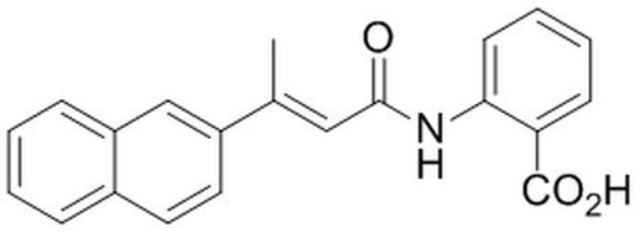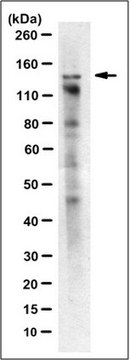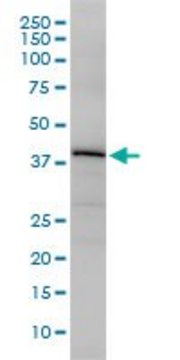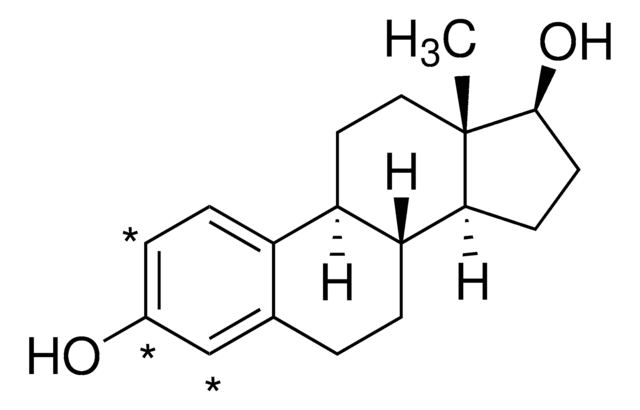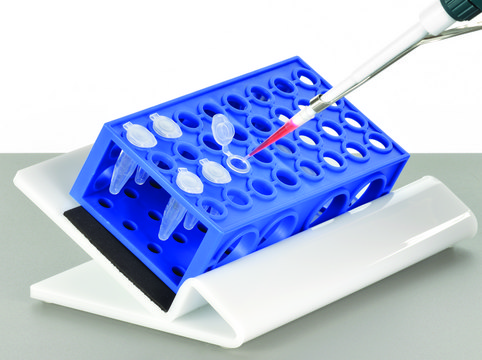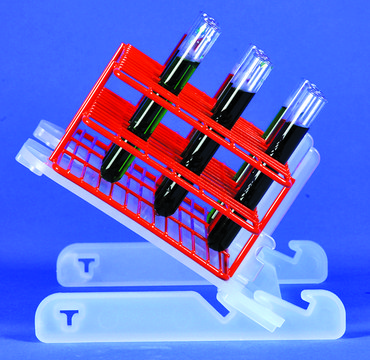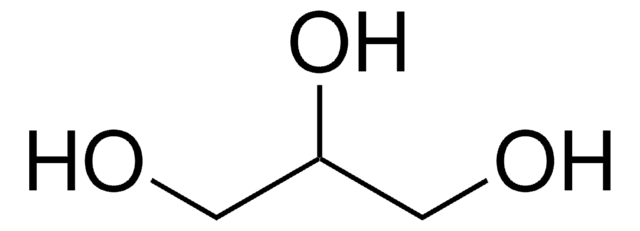推荐产品
生物来源
mouse
质量水平
抗体形式
purified immunoglobulin
抗体产品类型
primary antibodies
克隆
C482, monoclonal
种属反应性
human
技术
western blot: suitable
同位素/亚型
IgG2bκ
NCBI登记号
UniProt登记号
运输
wet ice
靶向翻译后修饰
unmodified
基因信息
human ... CTC1(80169)
一般描述
CST complex subunit CTC1 (UniProt Q2NKJ3; also known as Conserved telomere maintenance component 1, HBV DNAPTP1-transactivated protein B) is encoded by the CTC1 (also known as C17orf68, CRMCC) gene (Gene ID 80169) in human. CTC1 is a subunit of the trimeric CST (CTC1, STN1, and TEN1) complex that binds ssDNA, promotes telomere DNA synthesis, and inhibits telomerase-mediated telomere elongation. CST directly interacts with and stimulates DNA polymerase -primase (pol -primase) activity. CST also associates with and sequesters telomeric 3′ overhangs after their elongation by telomerase, thereby limiting further telomere extension by telomerase. Knockdown of either STN1 or CCT1 in human cancer cells and in mouse fibroblasts results in substantially elongated telomeric G-ove+D13rhangs. Conditional deletion of CTC1 in mice leads to early entry into senescence and signs of telomeric replication defects, Human CTC1 gene mutations casue dyskeratosis congenita (DC) and related bone marrow failure syndromes, as well as the rare autosomal recessive neurological disorder Coats Plus, where patients develop cranial calcifications and cysts. Coats Plus and DC patients develop premature hair graying, anemia, and osteoporosis as a result of telomerase defects.
特异性
Clone C482 targets an N-terminal region sequence present in both human CTC1 spliced isoforms reported by UniProt (Q2NKJ3).
免疫原
Linear peptide corresponding to an N-terminal region sequence of human CTC1.
应用
Anti-CST complex subunit CTC1, clone C482, Cat. No. MABE1103, is a highly specific mouse monoclonal antibody that targets CTC1 and has been tested in and Western Blotting.
Research Category
Epigenetics & Nuclear Function
Epigenetics & Nuclear Function
Western Blotting Analysis: 0.75-1 µg/mL from a representative lot detected the exogenously overexpressed CTC1 in 100-150 ng of lysate from transfected HeLa cells, as well as downregulated CTC1 expression following conditional CTC1 gene knockout in 150 ng of lysate from a HCT116 cell line harboring floxed CTC1 alleles (Courtesy of Carolyn Price, Ph.D. and Xuyang Feng, Ph.D., University of Cincinnati College of Medicine, U.S.A.).
质量
Identity Confirmation by Isotyping Test.
Isotyping Analysis: The identity of this monoclonal antibody is confirmed by isotyping test to be IgG2b .
Isotyping Analysis: The identity of this monoclonal antibody is confirmed by isotyping test to be IgG2b .
目标描述
~135 kDa observed. 134.61/114.1 kDa (isoform 1/2) calculated. Uncharacterized bands may be observed in some lysate(s).
外形
Protein G purified.
Format: Purified
Purified mouse IgG2b in buffer containing 0.1 M Tris-Glycine (pH 7.4), 150 mM NaCl with 0.05% sodium azide.
储存及稳定性
Stable for 1 year at 2-8°C from date of receipt.
其他说明
Concentration: Please refer to lot specific datasheet.
免责声明
Unless otherwise stated in our catalog or other company documentation accompanying the product(s), our products are intended for research use only and are not to be used for any other purpose, which includes but is not limited to, unauthorized commercial uses, in vitro diagnostic uses, ex vivo or in vivo therapeutic uses or any type of consumption or application to humans or animals.
未找到合适的产品?
试试我们的产品选型工具.
储存分类代码
12 - Non Combustible Liquids
WGK
WGK 2
法规信息
新产品
Zachary Mirman et al.
Nature, 560(7716), 112-116 (2018-07-20)
In DNA repair, the resection of double-strand breaks dictates the choice between homology-directed repair-which requires a 3' overhang-and classical non-homologous end joining, which can join unresected ends1,2. BRCA1-mutant cancers show minimal resection of double-strand breaks, which renders them deficient in
Xuyang Feng et al.
Nucleic acids research, 45(8), 4281-4293 (2017-03-24)
To prevent progressive telomere shortening as a result of conventional DNA replication, new telomeric DNA must be added onto the chromosome end. The de novo DNA synthesis involves elongation of the G-rich strand of the telomere by telomerase. In human
Xuyang Feng et al.
Nature communications, 9(1), 2827-2827 (2018-07-22)
Telomerase elongates the telomeric G-strand to prevent telomere shortening through conventional DNA replication. However, synthesis of the complementary C-strand by DNA polymerase α is also required to maintain telomere length. Polymerase α cannot perform this role without the ssDNA binding
我们的科学家团队拥有各种研究领域经验,包括生命科学、材料科学、化学合成、色谱、分析及许多其他领域.
联系技术服务部门